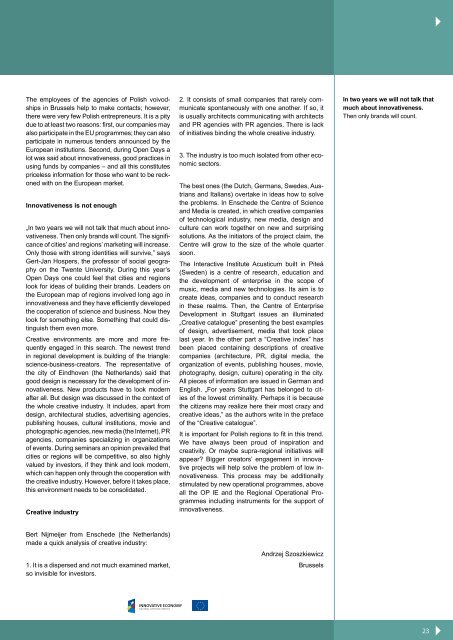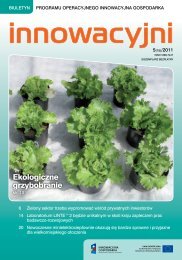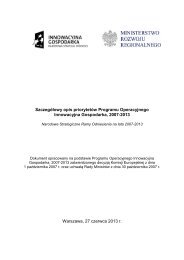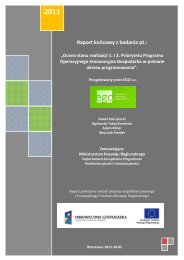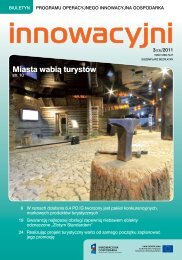The Innovative
The Innovative
The Innovative
You also want an ePaper? Increase the reach of your titles
YUMPU automatically turns print PDFs into web optimized ePapers that Google loves.
<strong>The</strong> employees of the agencies of Polish voivodships<br />
in Brussels help to make contacts; however,<br />
there were very few Polish entrepreneurs. It is a pity<br />
due to at least two reasons: first, our companies may<br />
also participate in the EU programmes; they can also<br />
participate in numerous tenders announced by the<br />
European institutions. Second, during Open Days a<br />
lot was said about innovativeness, good practices in<br />
using funds by companies – and all this constitutes<br />
priceless information for those who want to be reckoned<br />
with on the European market.<br />
<strong>Innovative</strong>ness is not enough<br />
„In two years we will not talk that much about innovativeness.<br />
<strong>The</strong>n only brands will count. <strong>The</strong> significance<br />
of cities’ and regions’ marketing will increase.<br />
Only those with strong identities will survive,” says<br />
Gert-Jan Hospers, the professor of social geography<br />
on the Twente University. During this year’s<br />
Open Days one could feel that cities and regions<br />
look for ideas of building their brands. Leaders on<br />
the European map of regions involved long ago in<br />
innovativeness and they have efficiently developed<br />
the cooperation of science and business. Now they<br />
look for something else. Something that could distinguish<br />
them even more.<br />
Creative environments are more and more frequently<br />
engaged in this search. <strong>The</strong> newest trend<br />
in regional development is building of the triangle:<br />
science-business-creators. <strong>The</strong> representative of<br />
the city of Eindhoven (the Netherlands) said that<br />
good design is necessary for the development of innovativeness.<br />
New products have to look modern<br />
after all. But design was discussed in the context of<br />
the whole creative industry. It includes, apart from<br />
design, architectural studies, advertising agencies,<br />
publishing houses, cultural institutions, movie and<br />
photographic agencies, new media (the Internet), PR<br />
agencies, companies specializing in organizations<br />
of events. During seminars an opinion prevailed that<br />
cities or regions will be competitive, so also highly<br />
valued by investors, if they think and look modern,<br />
which can happen only through the cooperation with<br />
the creative industry. However, before it takes place,<br />
this environment needs to be consolidated.<br />
Creative industry<br />
2. It consists of small companies that rarely communicate<br />
spontaneously with one another. If so, it<br />
is usually architects communicating with architects<br />
and PR agencies with PR agencies. <strong>The</strong>re is lack<br />
of initiatives binding the whole creative industry.<br />
3. <strong>The</strong> industry is too much isolated from other economic<br />
sectors.<br />
<strong>The</strong> best ones (the Dutch, Germans, Swedes, Austrians<br />
and Italians) overtake in ideas how to solve<br />
the problems. In Enschede the Centre of Science<br />
and Media is created, in which creative companies<br />
of technological industry, new media, design and<br />
culture can work together on new and surprising<br />
solutions. As the initiators of the project claim, the<br />
Centre will grow to the size of the whole quarter<br />
soon.<br />
<strong>The</strong> Interactive Institute Acusticum built in Piteå<br />
(Sweden) is a centre of research, education and<br />
the development of enterprise in the scope of<br />
music, media and new technologies. Its aim is to<br />
create ideas, companies and to conduct research<br />
in these realms. <strong>The</strong>n, the Centre of Enterprise<br />
Development in Stuttgart issues an illuminated<br />
„Creative catalogue” presenting the best examples<br />
of design, advertisement, media that took place<br />
last year. In the other part a “Creative index” has<br />
been placed containing descriptions of creative<br />
companies (architecture, PR, digital media, the<br />
organization of events, publishing houses, movie,<br />
photography, design, culture) operating in the city.<br />
All pieces of information are issued in German and<br />
English. „For years Stuttgart has belonged to cities<br />
of the lowest criminality. Perhaps it is because<br />
the citizens may realize here their most crazy and<br />
creative ideas,” as the authors write in the preface<br />
of the “Creative catalogue”.<br />
It is important for Polish regions to fit in this trend.<br />
We have always been proud of inspiration and<br />
creativity. Or maybe supra-regional initiatives will<br />
appear? Bigger creators’ engagement in innovative<br />
projects will help solve the problem of low innovativeness.<br />
This process may be additionally<br />
stimulated by new operational programmes, above<br />
all the OP IE and the Regional Operational Programmes<br />
including instruments for the support of<br />
innovativeness.<br />
In two years we will not talk that<br />
much about innovativeness.<br />
<strong>The</strong>n only brands will count.<br />
Bert Nijmeijer from Enschede (the Netherlands)<br />
made a quick analysis of creative industry:<br />
1. It is a dispersed and not much examined market,<br />
so invisible for investors.<br />
Andrzej Szoszkiewicz<br />
Brussels<br />
23


